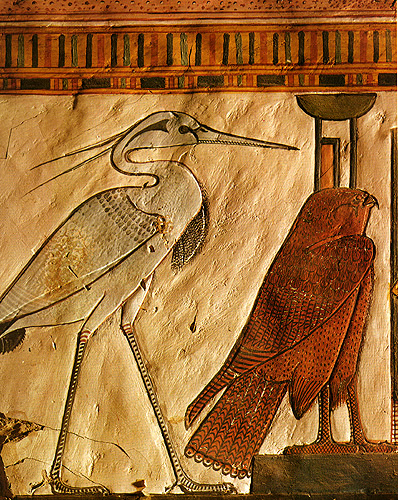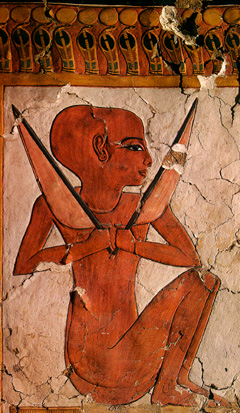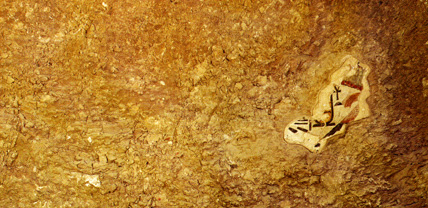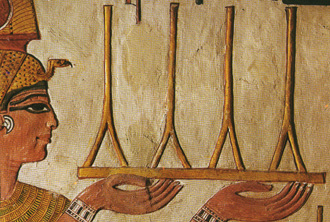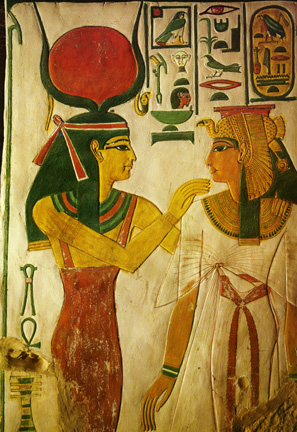Nefertari’s Tomb: The Second Chamber
On Osiris’ “Gatekeepers”
Knot-Glyph
Underground Fashion; or, Topless Goddesses
Queen Nefertari Herself
Hathor’s Touch
On Osiris’ “Gatekeepers”
In Nefertari’s tomb, resurrection glyphs live in comfortable company with death-glyphs. The Egyptian phoenix-bird, immortally rising from its own ashes, is depicted as a heron on the banks of the Nile, with an equally noble bird, the falcon, to its right.
The draftsman’s incised line is as sure, as perfect and heroic, as the bird’s reconstitution from nothingness, raising stunning images out of a bare wall: [Right]
One of Osiris’ “gatekeepers” in Nefertari’s tomb, a guardian figure where one room leads into another, looks just like a new-born baby, his or her (?) head still mis-shapen from his mother’s labor [see below]:
What is this baby-figure holding? Knives? What would they signify? (Perhaps a reference to what cut the umbilical cord?)
Knot-Glyph
While thinking about life-symbols, consider also this gnomic knot figure [to left, shown much enlarged].
It may be combined with many other hieroglyphs to mean different things. When paired with a sun symbol, as it often is, it means “eternal.”
As if (perhaps) life itself were a twist in the thread of eternity, a convoluted inwardness and crossing that each time it occurs produces particular individuals, singular souls.
This knot-glyph also has a hauntingly bipedal quality, like a human walking or standing upright. And of course it’s not really a tight knot at all, only a little twisting:
as if each of us were just a temporary configuration,
a slip knot….
And then there are the ironies, the new readings, inscribed by time’s erasures. On one wall where the fresco has almost completely crumbled to dust only a small fragment remains, part of a cartouche and a wing image that were meant to depict protection.
Underground Fashion; or, Topless Goddesses
Now let’s brighten things up a bit, for Nefertari’s tomb definitely celebrates life, not just the afterlife. Let’s talk fashion.
One of Nefertari’s guardian-spirits, the goddess Neith, wears this stunning little number as she goes about her business helping Nefertari adjust to the new experience of being dead [to the left]. Nefertari’s not sure how to handle herself, or where to turn or what to do as she starts her journey to the afterlife. Just as important: what should she wear? But Neith is there to help. And not just by standing around; Ms. Neith looks fabulous. Can anyone imagine a more elegant dress—and also a sexier one—than this one? Topless, it lets the goddess’ heavenly breasts peek out amidst the shoulder straps.
The pattern is pretty classy too. Close-up, below, we can see how the paint has worn after three thousand years: the marring of the paint is like fabric, fraying.
There are some other great fashion moments in the tomb. A leopardskin ensemble, for instance, here shown in close-up, to the left:
Queen Nefertari Herself
And here is the first picture I will show you of Queen Nefertari [to right]. She is bearing a gift of fine cloth to the gods. (When you journey to the afterlife and seek the gods’ protection, it is always a good idea to bring some presents.)
In this fresco, she brings her gifts to the god Ptah, the dark-skinned chief god of the city of Memphis also known as the maker of the male human body. (See Ptah’s image in the section on skin tones in the Nefertari paintings, in the “First Chamber” section of the Tomb Tour. Ptah may be compared to the Yoruba god Ogun and the Greeks’ Hephaestus [?].)
Here’s a fascinating detail: Nefertari does not bring cloth itself to Ptah. She brings the hieroglyph for cloth—four of them. What is the meaning of such a gift? Note also Nefertari’s head-dress and eye-shadow, and her earring. Plus her erect posture, her pride in this moment.
I’m keeping the best secret still—what Nefertari is wearing. To find this out,
scroll down.
Hathor’s Touch
Neith is not the only Egyptian goddess who accompanies Nefertari on her journey to the afterlife. Two of the most important, Hathor and Isis, are often by her side, as shown in two of the climactic pictures in the tomb. This image features Hathor, goddess of the sky, the female counterpart of Osiris, god of the underworld. She was sometimes represented as a cow with a sun-disk held up between two horns—but here just the horns and sun-disk are emphasized. Hathor’s figure is anything but bovine. Like Isis, she is associated with love, mirth, and joy. And she’s wearing another one of those great topless dresses!
Hathor is on the left, embracing Nefertari, who wears a more discreet and proper—but still fine—white dress. Such a dress perhaps is more appropriate for the newly dead?
Or is Hathor reaching out to touch Nefertari’s shoulder, maybe to adjust a little Nefertari’s rather imposing, wingèd headdress? Either way, this image radiates tenderness and friendship. Nefertari is now ready for her final crossing to the next world.
Would that we all could have such a tender guardian when we must cross over….
Go to the Third & Final Chamber
Or, Return to Tour Guide

